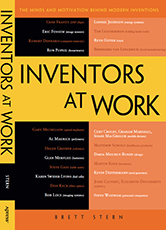|
Inventors at Work
Purchase Information
Website
InventorsAtWork.com
Retailers and Ebooks
Amazon.com

|
Apress.com

|
Barnes and Noble

|
 This book is a collection of interviews conducted with individuals who have distinguished themselves in the invention space. Some of the inventors interviewed here have their Aha! moments in government, institutional, or industrial labs; develop their inventions with multidisciplinary teams of experts; and leave the marketing of their inventions to other specialists in the organization. Some inventors in this book develop their inventions with small teams in academic labs and try to translate their research into product via licenses or startup companies. Other inventors I interviewed carry on the classic lone-inventor-in-his-garage tradition and take on the task of bringing their products to market themselves. And a few mix and match their strategies, bringing skills honed in big labs home to their garages and licensing their personal inventions to big corporations. This book is a collection of interviews conducted with individuals who have distinguished themselves in the invention space. Some of the inventors interviewed here have their Aha! moments in government, institutional, or industrial labs; develop their inventions with multidisciplinary teams of experts; and leave the marketing of their inventions to other specialists in the organization. Some inventors in this book develop their inventions with small teams in academic labs and try to translate their research into product via licenses or startup companies. Other inventors I interviewed carry on the classic lone-inventor-in-his-garage tradition and take on the task of bringing their products to market themselves. And a few mix and match their strategies, bringing skills honed in big labs home to their garages and licensing their personal inventions to big corporations.
This is not a recipe book. It doesn’t aim to reduce invention to a series of foolproof steps: how to take an idea, go through the R&D process, develop prototypes, create intellectual property, build a brand, raise capital, and get product on store shelves. Rather, this book invites readers to touch their own creative impulses to the fires of real inventors speaking candidly about what possesses them every day of their lives: the passion to invent.
These privileged conversations have confirmed my belief that inventors are born to be inventors. Of the multitudes of clever people who get technical degrees in engineering and scientific fields, only a fraction contrive to add patents to their credentials. It is the rare individual who can combine curiosity, intellectual powers, mechanical knack, and focused awareness to see a novel solution to a problem and then convert that insight into a physical invention that works. (For the sake of coherence, I decided to interview only the inventors of physical products, and not the inventors of software products.)
This collection of interviews shows how a startling variety of inventors—selected for their widely divergent backgrounds, educations, fields, interests, personalities, age, gender, ethnicities, business circumstances, and invention types—share the ability and indeed the compulsion to create ideas and objects that are useful, exciting, and unprecedented. Some of the inventions described here by their creators have transformed the world; others simply made the world a more fun place to live. But all of these different inventions drew on an array of common traits in their inventors: perseverance, drive, motivation, a touch of obsession, and—most importantly—the welcoming of failure as a opportunity to learn and push their ideas forward.
The intent was to talk about the process they go through, not so much the product they invented. I was also struck by the fact that most of the inventors I interviewed expressed a similar set of preferences and work habits. They like to work on multiple projects simultaneously in multidisciplinary teams, freely sharing their ideas with others. They reach out to experts in other fields and ask lots of questions. They wake up in the middle of the night and sketch out their ideas on paper or visualize them vividly in their heads. They prototype ideas using materials that they are comfortable working with. They use physical exercise to relax their minds and jack up their concentration. They seek mental stimulation and different tempos of thought in areas outside their specialties. Most strikingly, they value slow time to ponder alternative opportunities. And finally, they said they would never retire from being an inventive person or stop working on a project that interests them.
COPYRIGHT 2012: Brett Stern – ALL RIGHTS RESERVED.
|

